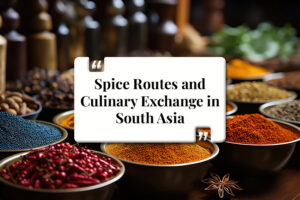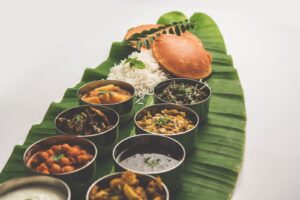Introduction
Venturing into the diverse and enticing realm of street food cultures in India and Pakistan is a journey. That promises to awaken all of your senses. As you navigate the bustling streets filled with aromatic spices and vibrant colors. You will also be greeted by a myriad of options ranging from savory street vendors to iconic popular snacks. That have become synonymous with the local culinary scene. Each bite tells a story, weaving together a rich tapestry of flavors. That reflect the unique history and traditions of these countries. Embark on a gastronomic tour with us as we explore the essence of food culture in these regions. Discovering the hidden gems and culinary delights that await around every corner.
India and Pakistan
India and Pakistan are home to some of the most tantalizing street food delights that will leave your taste buds tingling with delight. From the famous chaat stalls that offer a burst of flavors in every bite to the sizzling kebabs that are grilled to perfection.The street food scene in these countries is a true feast for the senses. As you immerse yourself in the vibrant culture of these regions, you will witness the passion and creativity. Which also goes into creating these mouthwatering dishes that have become an integral part of the local food culture. Join us as we delve deeper into the world of street food, uncovering the stories behind each dish and exploring the traditions. That have shaped the culinary landscape of India and Pakistan.
Streets of India and Pakistan
The streets of India and Pakistan are a playground for food enthusiasts, offering a treasure trove of culinary delights that cater to every palate. Whether you are a fan of spicy snacks or have a sweet tooth that craves indulgence, the street food culture in these countries has something for everyone. From the pani puri stalls that serve up a refreshing burst of flavors to the aromatic biryani that is cooked to perfection, there is no shortage of delicious options to choose from. As you meander through the bustling streets, you will be captivated by the sights and sounds of the vibrant food scene, each vendor eager to share their unique creations with you. Join us as we take you on a culinary adventure in India and Pakistan. Each bite you take will showcase the diverse and vibrant food culture of these countries.
The Street Food Scene in Pakistan
Overview of popular snacks in Pakistan
Pakistan’s street food scene is a vibrant tapestry of flavors and aromas that reflect the country’s rich culinary history. The multitude of dishes available ranges from the sizzling seekh kebabs to the fragrant biryanis, each one with a story to tell about tradition and innovation. Among the must-try items are the iconic golgappas, also known as pani puri, which burst with tangy flavors that leave both locals and tourists craving more. As one meanders through the bustling streets of Karachi and Lahore, the enticing aroma of freshly fried pakoras fills the air while the sizzle of spicy chicken tikka adds to the sensory experience. Every bite taken in Pakistan’s street food scene is like embarking on a culinary journey through the country’s diverse landscape, an exploration of the creativity and passion that its people infuse into their food.
Unique flavors and dishes in Pakistani street food
When exploring the unique flavors and dishes in Pakistani street food, one cannot overlook the mouth-watering nihari, a slow-cooked stew bursting with spices and tender meat that has become a beloved comfort food across the country. Another must-try dish is the flavorful chapli kebab, a patty made with minced meat and a blend of aromatic spices that is grilled to perfection. For those with a sweet tooth, the decadent jalebi and creamy kulfi are popular choices that provide a delightful end to a savory street food adventure in Pakistan. Each bite offers a glimpse into the culinary traditions and cultural diversity that make Pakistani street food a true delight for food enthusiasts.
Comparison of street food cultures between India and Pakistan
India and Pakistan both have a variety of street foods that show their different culinary histories. In India, street food is known for its vibrant colors, bold flavors, and aromatic spices. Popular street foods include chaat, vada pav, dosas, and samosas. Each region in India offers its unique twist on street food, showcasing a wide variety of vegetarian and non-vegetarian options. On the other hand, Pakistan’s street food scene is characterized by dishes like seekh kebabs, biryanis, golgappas, pakoras, and chicken tikka. Pakistani street food is known for its robust flavors and generous use of spices, offering a delightful culinary experience for locals and tourists alike.
While both countries share a love for spicy and flavorful dishes, the street food cultures in India and Pakistan differ in terms of specific dishes, flavors, and cooking techniques. Exploring the street food scenes in both countries provides a fascinating insight into the culinary diversity and cultural influences that shape these gastronomic experiences.
The Street Food Scene in India
Exploring Street Food in India
Exploring street food in India is a delightful journey through a myriad of flavors and aromas. India’s street food scene is renowned for its vibrant colors, bold flavors, and aromatic spices. Popular street foods in India include chaat, vada pav, dosas, and samosas, each offering a unique culinary experience. Every region in India showcases its twist on street food, providing a diverse range of vegetarian and non-vegetarian options to tantalize your taste buds. Whether you are a fan of spicy snacks or crave something sweet, India’s street food culture has something for everyone, making it a must-visit destination for food enthusiasts.
Influence of regional cuisines on street food culture
Regional cuisines have a big impact on the types of street food you can find. In India and Pakistan, the diverse regional cuisines contribute to the unique flavors and ingredients found in their street food. For example, in India, regions like Punjab are known for their rich and hearty dishes like butter chicken and chole bhature, which have influenced street food offerings in those areas. Similarly, in Pakistan, the culinary traditions of provinces such as Sindh and Punjab have influenced the street food scene, with dishes like Sindhi biryani and Lahori chargha being popular choices. These regional influences add depth and diversity to the street food culture, creating a tapestry of flavors that reflect the culinary heritage of each area.
Street food vendors and their role in preserving culinary traditions
Street food vendors are important because they keep old recipes and cooking methods alive by teaching them to their children. These vendors often represent the heart and soul of a region’s food culture. Showcasing authentic flavors and dishes that have been cherishing for years. Moreover, by continuing to prepare traditional street foods and sharing them with locals and tourists. Street food vendors help maintain the culinary heritage of a place alive. They work hard to make sure that the special flavors and cultural importance of the food stay the same. This lets people enjoy and understand the food history of a place.
Cultural Significance of Street Food
Discussing the cultural and social aspects of street food in India and Pakistan
Street food is very popular in India and Pakistan. In both countries, street food is not just about satisfying hunger. It’s also a way of life, a social activity, and a cultural experience. In India, street food brings people together, no matter their background, to enjoy tasty dishes. It reflects the country’s diversity, with each region offering its unique culinary delights. Street food vendors often share recipes with their family over many years. This keeps old ways of cooking alive and brings people together over food.
Similarly, in Pakistan, street food is deeply ingrained in the social fabric. It provides a platform for people to gather, interact, and bond over delicious meals. The street food scene in Pakistan showcases the country’s rich culinary heritage and serves as a testament to the creativity and passion of its people. Food vendors on the street are important in both countries because they keep cultural traditions alive.
These sellers make and sell food from India and Pakistan to keep their culture alive. They cook and serve authentic dishes for people in the area. Street food in these countries is about more than just food. It also represents community, tradition, and shared experiences.
How street food reflects the diversity and heritage of each country
Street food in India and Pakistan shows the different flavors, ingredients, and cooking styles of each country’s culture. It reflects their heritage and diversity. In Indian food represents the country’s culinary diversity, with each region offering its unique twist on popular dishes. The vibrant colors, bold flavors as well as aromatic spices. Which is using in Indian street food highlight the rich heritage and cultural influences present in the cuisine.
In contrast, Pakistani street food has strong flavors and uses lots of spices. This shows the country’s food history and local influences. The unique flavors as well as dishes found in Pakistani street food, such as nihari, chapli kebab, and jalebi, provide a glimpse into the country’s diverse culinary landscape and cultural traditions. In India and Pakistan, street food shows different tastes from different areas. It’s an important part of the food experience in these places.
Street food as a unifying factor in the culinary landscape
Street food cultures serves as a unifying factor in the culinary landscape by bringing people together to enjoy a shared love for flavorful dishes. The Street food in India and Pakistan highlights each country’s unique culture. There are many dishes to choose from, suiting everyone’s tastes. Moreover, street food vendors are important because they keep old food traditions alive and bring people together through food. Street food brings people together to share tasty food and form connections with each other. It brings people together to connect over things they have in common. Overall, street food acts as a common thread that ties together people from various backgrounds. Furthermore showcasing the culinary heritage and passion of both nations.
Street Food Innovation
Evolution of traditional street foods in modern times has seen a fusion of traditional recipes. With modern culinary techniques as well as ingredients. Street food vendors are also adapting to changing consumer preferences by offering healthier options. Which is incorporating global food trends, and experimenting with new flavors and presentations. This evolution also allows traditional street foods to stay relevant and appealing to a wider audience. While still preserving their cultural roots and authenticity.
The fusion of flavors and techniques in street food cultures involves blending traditional recipes with modern culinary methods and ingredients. Street food vendors, rooted in Street Food Cultures, adapt to changing consumer preferences by experimenting with new flavors, incorporating global food trends, and presenting dishes innovatively. This blend maintains the popularity and intrigue of old street foods while honoring their cultural heritage
Please keep in mind that your request might not have anything to do with the article. New street food in India as well as Pakistan is getting more healthy, mixing old recipes with new ways of cooking, using global food trends. It also trying out new tastes and styles. Street food vendors are also adapting to changing consumer preferences by offering a wider variety of dishes. Which also cater to different tastes and dietary requirements. This evolution in street food culture allows for the preservation of culinary traditions while appealing to a broader audience.
Conclusion
To recap the gastronomic tour through the street food cultures of India and Pakistan, it becomes clear that street food plays a much larger role beyond simply satisfying hunger. It is deeply ingrained in the way of life, serving as a social activity and a cultural experience that showcases the diversity and heritage of each country. Street food from India and Pakistan has a variety of flavors, ingredients, and cooking styles that reflect their cultural heritage.
street food culture in India and Pakistan, with its vibrant colors, bold flavors, and aromatic spices, highlights the rich heritage and cultural influences present in the cuisine. Pakistani street food has strong flavors and uses lots of spices. It shows the country’s food history and different regions. Enjoying the different food from India and Pakistan on the streets is a fascinating way to explore their rich food and culture.
Street food in these regions has evolved by combining old recipes with new cooking methods and ingredients. Street food culture can keep old recipes alive and attract more people with new tastes. It shows how street food can change and make new things. Also encouraging readers to explore and savor the rich tapestry of flavors and aromas found in the street food. Of India as well as Pakistan is an invitation to immerse oneself in the cultural richness. regional cuisines. Furthermore culinary heritage of these nations firsthand. By indulging in the diverse street food offerings. One can truly appreciate the sense of community, tradition as well as shared experiences. That street food embodies in these countries. It is also an opportunity to connect with the people and traditions. That have shaped the vibrant street food scenes in India and Pakistan, creating memorable experiences that go beyond just a taste sensation.









